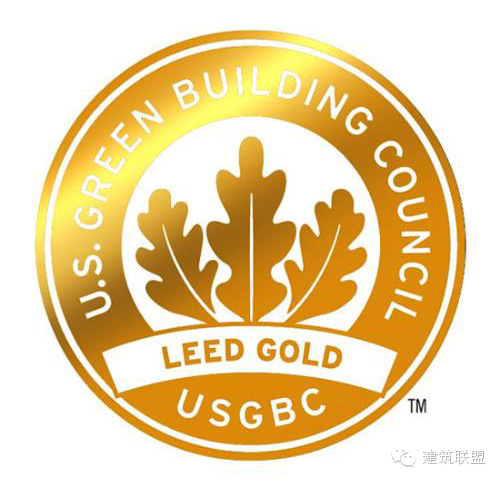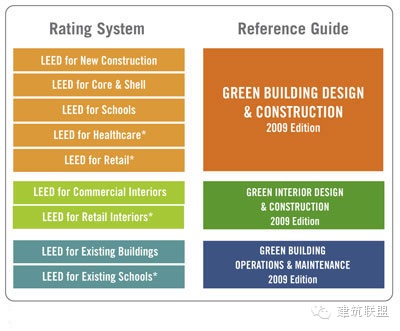What's LEED Certification

Know LEED Certification
LEED certification is the current most advanced and practical green building certification rating system in the world. The system will help project teams to clear goals of green building and make practical design strategy, make project teams achieve international certification system’s index and standards, provide high quality, low maintenance, healthy and comfortable working environment.
LEED certification was founded and implemented by USGBC in 1998, full name is Leadership in Energy & Environmental Design Building Rating System, it was called LEED in short in the world. It is regarded as the most improved and influential rating system among all kinds of building environmental protection rating standards, green building rating standards and building continuable rating standards.

Types of LEED
LEED NC
LEED for New Building and Major Renovations
LEED for New Building and Major Renovations (thereafter referred to as LEED NC) is directed against New Building (or Major Renovations). It is mainly for the purpose of guiding high performed design and construction process of commercial buildings and public institutions, especially for office buildings.
Types for LEED NC’s buildings: office and commercial, retail shops, project groups for many buildings, medical and health care projects, labs, data centers etc..
LEED EB
LEED for Existing Building
The philosophy of LEED EB is to mostly enlarge the existing building’s operation efficiency, at the same time to mostly decrease the influence on environment, to provide one rating system for buildings owners and property management companies, to compare and verify actual results of renovations, improvements, and maintenance.
As the wildly recognized green building rating system in the US, LEED EB certification is helpful to show the commitment and guiding value in aspect of environmental protection, to attract new tenants for existing buildings, meanwhile, it’s also the humanistic care passed to employees and societies by the Companies.
LEED CI
LEED for Commercial Interior
Be directed against renting office or shop only, instead of new building, since those tenants only control internal decoration, and the other parts of the whole building is under the control of the owner, be directed against the internal decoration market, USGBC launched LEED for Commercial Interior, in short called LEED CI.
In terms of renting areas’ decoration and renovation, LEED CI is ideal rating system for green design and green constructing. According to LEED CI’s advice, tenants, their design team, constructing team are enabled to take all kind of continuous developable design methods in the areas controlled by them, provide internal environment in the whole renting areas.
LEED CS
LEED for Core & Shell
In the highly developed commercial society, after one building was build up, its internal space usually will be rented to different businesses. This model is so called Core & Shell developing model. Core refers to every tenant who constitute the core area of the building. On the other hand, the constructor and the owner are Shell, i.e., be responsible for developing, managing, and operating public areas of the building. Because those tenants only can control the implementing of internal decoration, the rest areas are under the control of the owner, to encourage the owner to use continuous developing concepts of green environment protection during the whole building’s design and constructing, USGBC launched LEED for Core & Shell rating system, in short called LEED CS.
LEED CS’ aim is to expect to build up harmony interaction’s relationship between the constructor’s developing process and the future tenants’ decorating process, to let the future tenants’ commercial internal decoration be able to use the constructor’s existing green and environment protection strategy to the greatest extent. LEED CS is focus on the building’s design of building, structure, and Mechatronic Systems. The combination of LEED CS an LEED CI provides one set of complete, both internal and external concerned green building constructing guide and rating system for the building’s constructor, owner, and tenants.
LEED-H
LEED for Home
The main types of LEED for Home include solo structure on solo base, solo house of single family, loft, row houses, Town House (multi jointed 2 or 3 level house) etc. If the size of the project is big, LEED NC standards is suggested.
LEED ND
LEED for Neighborhood Development
LEED for Neighborhood Development is the rating system developed by USGBC, Congress for New Urbanism,in short called CNU and Natural Resources Defense Council, in short called NRDC.
Process of LEED Certification
Register
To apply LEED certification, project teams should fill out project registration form and register in GBCI website, then pay registration fees to get related software tools, corrigendum
and other key information. The project will be put in LEED Online database after registered.
Prepare application documents
The project applying for certification shall fully meet the preconditions and the lowest scores in LEED rating system. During the process of preparing application documents, according to every indicator’s requirement, project team shall collect related information and calculate, prepare related materials according to every indicator’s requirement.
Submit application documents
Before the final date made by GBCI certification system, the project team shall upload the complete application documents, pay related certification fee, and then start the review process.
Review application documents
According to different certification system and review paths, the review processes of application documents are different too, include documental review and technical review in general. GBCI will finish the documental review of application documents in one week after received the application documents, mainly according to the requirements in the checking list, check if the documents are qualified or complete or not, if the provided documents are not enough, the project team will be informed which documents are missing. If the documental review passed successfully, technical review can be started. In two weeks after documental review passed, GBCI will provide one set of pre-reviewed LEED documents to the project team. The project team has 30 days to correct and supplement the application documents and resubmit to GBCI. GBCI will finally review the corrected application documents in 30 days, the suggest one final score to LEED guiding committee. The guiding committee will made final decision (accept or reject) in two weeks and then inform the certification result to the project team.
Offer Certificate
In certain period after received LEED’s certification notice, the project team may response to the certification result, if no disagreement, the certification process is over. The project is listed as LEED certified green building, USG-BC will offer the certificate and LEED mental plaque marking the certificated level to the project team.

LEED rating system
LEED rating system’s technical framework combined by five big aspects and a few indicators. LEED rating system overall considers and judges the impact of environment from the aspects of sustainable site development,water savings,energy efficiency,materials selection and indoor environmental quality, marks according to every aspect’s indicator, concludes result score, identifies the building as platinum, gold, silver and certified level via evaluation, in order to show the building’s green level.
LEED marks the score according to every aspect: sustainable site development, building water saving, energy using and atmosphere protection, material and energy, indoor environmental quality, innovation and design procedure, Full score is 110, divided as 4 certificated levels:
Certificated level 40-50
Silver level 50-60
Gold level 60-80
Platinum level above 80

Detailed considering factors are as below:
1、Sustainable Sites
Sustainable Sites includes conservation of soil and water and surficial deposit control, maintain, and recover public green surface, reduce outdoor light pollution, reasonable tenant design and constructing guideline.
2、Water Efficiency
In Water Efficiency part, LEED-CS divides water saving into three score aspects, i.e., reducing water using for landscape purpose, water saving by using advanced technology, reducing general daily water using. May use rain recollection technology and reclaimed reuse technology etc..
3、Energy & Atmosphere
First, the process of constructing shall meet the lowest energy consuming standard. There is clear explanation of low energy consuming during constructing process in ASHARE STANDARD, LEED also refer to this standard to define that whether energy consuming can meet the energy consuming standard required by LEED. Main technology is to use refrigerant without freon, to use 2 level low-e glass, to optimize heat preservation and sunshade system, to design passively, to install individual measuring system, to choose energy saving air-conditioner, to install energy reusing system like solar energy, wind energy etc..
4、Materials & Resources
In terms of materials wasting issue, during LEED certificating process, pathbreaking added material and resources using scoring point. This scoring point is aimed at popularizing energy reasonable using during constructing process, tries to use reusable material, reflects in LEED certificating process by adding the score. Below points are considered during materials and resources evaluation: recyclable materials’ storing and collecting, management of constructing trash, resources reusing, renewable ingredients, local materials using ratio.
5、Indoor Environmental Quality
Indoor Environmental Quality monitoring is mainly to monitor built building and indoor environmental quality. In the process of this, below points are considered, which is, the lowest requirement of indoor environmental quality, control of smoking area, Ventilation monitoring, improve the air flow, managing indoor environmental quality in building rooms, application of low volatility material, indoor chemical material’s using and controlling, system’s controlling, thermal comfort, natural lighting and horizon distribution. Applied technical solutions include install Ventilation monitoring system, install independent venting system in the areas with dangerous atmosphere or the areas storing or using Chemical products.
6、Innovation & Design Process
Design innovation means that it can get extra innovation score by adding reasonable, innovative, energy saving and environmental protecting design philosophy during building design process. Those philosophies are above LEED certification standards in certain extent.
LEED’s development in China
LEED entered China contrition market in 2003. Projects starts to be registered in 2004, LEED offered certification to projects in 2005. Together with LEED’s acceptance level’s improvement, registered or certified projects become more and more year by year, until January 2012, applied LEED projects in China reached more than 800 and the number of certificated projects is 195 in total.
Known from the data in the Chart, the number of China’s LEED certified projects, it jumped three levels among 2009, 2010, and 2011, certified number achieved 85. Someone pointed out, China become the second big LEED certified country in the world, just after America.
Whereas currently green building is hot in China. There are experts anticipated, in the future two years, our green building will continue increase explosively. LEED’s certification in China shall develop in deep。
LEED’s environment protection value
Quantifying every indicator of environment and building. The judgement of LEED certification system against building is not only stop on defining analysis but also deep quantitative analysis according to ASHARE standards.
1. Energy using shall reach the constructing energy saving and technical standards or local energy saving standards in ASHARE/IESNA 90.1-2007, and to further save 20%-60% on this basis.
2. Water using cost reduces 20%-30%.
3. Indoor air quality shall reach ASHARE62-2004’s lowest requirements or better.
4. Reduce solid waste discharging 30%-40%.
LEED’s market value
1、LEED is directed to the project groups who are willing to lead Market, apply green constructing technology earlier relatively. As authoritative third-party evolution and certification result, LEED is helpful to improve those green building’s reputation in local market and acquire good property value assessment.
2、Besides publicizing all goodness of green building, it is more important for LEED system to tell investors that, green buildings are worth more value, easier to get more payback than other products. Actual value of green building is improved, thus differing from other products. This is a virtuous circle,thus push Market to transform.
3、Along with Market’s coming into being, companies may choose to build green building, to reflect Companies’ carness and social responsibilities in front of employees, customers, and investors. Moreover, green building is also to save operation cost for Companies, improve employees’ efficiency, reduce sick leave’s ratio, is helpful to keep good employees, since people always is prone to work in green buildings.
(Reprint)
